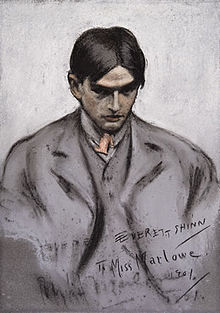Everett Shinn
| Everett Shinn | |
|---|---|

Self-portrait done in 1901 in his charcoal style.
|
|
| Born |
November 6, 1876 Woodstown, New Jersey |
| Died | May 1, 1953 (aged 76) New York City, New York |
| Nationality | American |
| Known for | painting, set design |
| Movement | Modernism, realism |
Everett Shinn (November 6, 1876 – May 1, 1953) was an American realist painter and member of the Ashcan School. He also exhibited with the short-lived group known as "The Eight," who protested the restrictive exhibition policies of the powerful, conservative National Academy of Design. He is best known for his robust paintings of urban life in New York and London, a hallmark of Ashcan art, and for his theater and residential murals and interior-design projects. His style varied considerably over the years, from gritty and realistic to decorative and rococo.
Shinn was born in Woodstown, New Jersey, a large Quaker-dominated community. His parents Isaiah Conklin Shinn and Josephine Ransley Shinn were rural farmers. Their second son, he was named for the author Edward Everett Hale, of whom his father was a great fan. "Shinn's ability to draw was evident from very early childhood." At age 15 he was enrolled at the Spring Garden Institute in Philadelphia, where he studied mechanical drawing. The following year he took classes at the Pennsylvania Academy of the Fine Arts, and by age 17 was working as a staff artist for the Philadelphia Press. Moving to New York City in 1897, he was soon known as one of the more talented urban realists who were chronicling in paint the energy and class divisions of modern metropolitan life. In 1898 Shinn married Florence "Flossie" Scovel, another artist from New Jersey; in 1912 they divorced, and in 1913 he married Corinne Baldwin, going on to have two children, Janet and David. By 1933 Shinn had divorced two more wives and was the subject of many tabloid rumors. Though he exhibited less frequently later in his life, Shinn had a well-established career by the 1920s but suffered serious financial losses during the Depression and sold very few paintings during that time. Between 1937 and his death in 1953, Shinn received several awards for his innovative paintings and participated in a number of exhibitions; he would always be associated, however, with the achievements of the Ashcan School of American art circa 1900-1920. He died of lung cancer in New York City in 1953. Shinn was reportedly a model for the talented, promiscuous artist-protagonist of Theodore Dreiser's 1915 novel The "Genius". With his well-known taste for the good life, Shinn was dubbed by art historian Sam Hunter "the dandy of the realists."
...
Wikipedia
